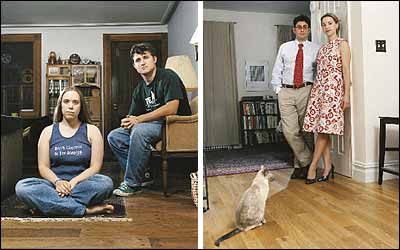
On a recent Tuesday, a small group of young New Yorkers met in the West Village, not for after-work margaritas, but to talk about the varying consistencies and textures of cervical mucus (and the importance of analyzing it every night). They were there to learn about “Natural Family Planning” (NFP), the Catholic Church’s modernized version of the rhythm method. It’s the latest answer to a longstanding Vatican problem, that the doctrine banning contraceptives is likely the Church’s most-ignored prohibition—other than, perhaps, premarital sex. Especially in Manhattan, where two-career couples probably aren’t prone to trust the rollout of their progeny to happenstance.
Just in time to stay right with the Church in the strict Pope Benedict era, these couples came to St. Vincent’s Hospital for a class in the “Creighton model,” the most mucus-centric form of NFP (named after a Nebraska doctor who helped develop it). No talk of sin here; instead, they get New Age-y female-empowerment brochures about “Freedom” for women (“Tailor Made for YOU!!”).
NFP dates to Pope Paul VI’s “Humanae Vitae” encyclical, which called upon scientists to “elucidate more thoroughly the conditions favorable to a proper regulation of births.” Under Creighton, couples record mucus daily and report results to a counselor, who draws up a fertility chart. A woman looks for “the three Cs: color, consistency, and change.” When mucus is “stretchy, clear, and lubricative,” she’s more fertile. Pamphlets call the method 99 percent effective.
Couples call it relationship-enhancing. “I wasn’t compelled to be here,” says Bob Nardo, a 23-year-old music teacher who, in his green Converse high-tops and earring, looks anything but choirboy. He’s an ex–lapsed Catholic; his fiancée, lifelong Upper West Sider Sara Butler, is Protestant. But the two agree on NFP. “The way most young people think about having sex and contraception, it’s all very disconnected,” says Nardo. “This makes it that much harder to look at your partner as a sexual object,” adds Butler. Indeed, during class, an instructor warns men, “Hold on to your chairs. You’re about to learn more about a woman’s body than you ever wanted to know.”
But will New York women flock to the method? Michele Cosentino, an art director, and her fiancé, Ari Greenman, a financial adviser, aren’t convinced. “It just doesn’t seem very Manhattan-like to me,” she says. “I probably will choose something similar when I am married, but until then, what if I got pregnant? Forget it!” The couple want to get married in the Church and are required to attend the class, and although Greenman, who’s Jewish, didn’t think “it was so bad,” asking his future wife about her fertility still isn’t his idea of fun. “The first thing we want to do each night is not checking for mucus.”
Though classmates differ on whether cervical mucus makes for good brunch conversation, Random House book designer Joanne Yates has been surprised by the level of interest when singing NFP’s praises to female co-workers. “Many of them have had trouble with the Pill,” she says. “Something more natural sounds appealing.”
And in this age, when conservatives often take on the mien of rebellion, there’s the culture-warrior attraction, too. Butler is loud and proud about NFP: “I bought a shirt that says BIRTH CONTROL IS FOR SISSIES.” But parenthood isn’t. Her fiancé, Nardo, recalls his parents’ reaction when he told them of his and Butler’s decision. “They were like, ‘Ohhh, wow, we tried that, and then you were born.’ ”